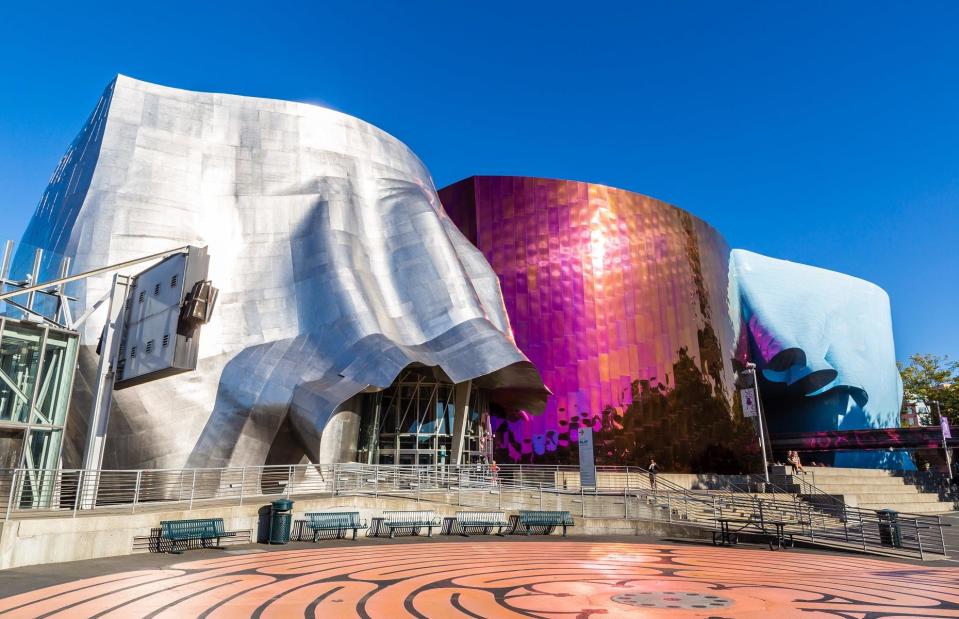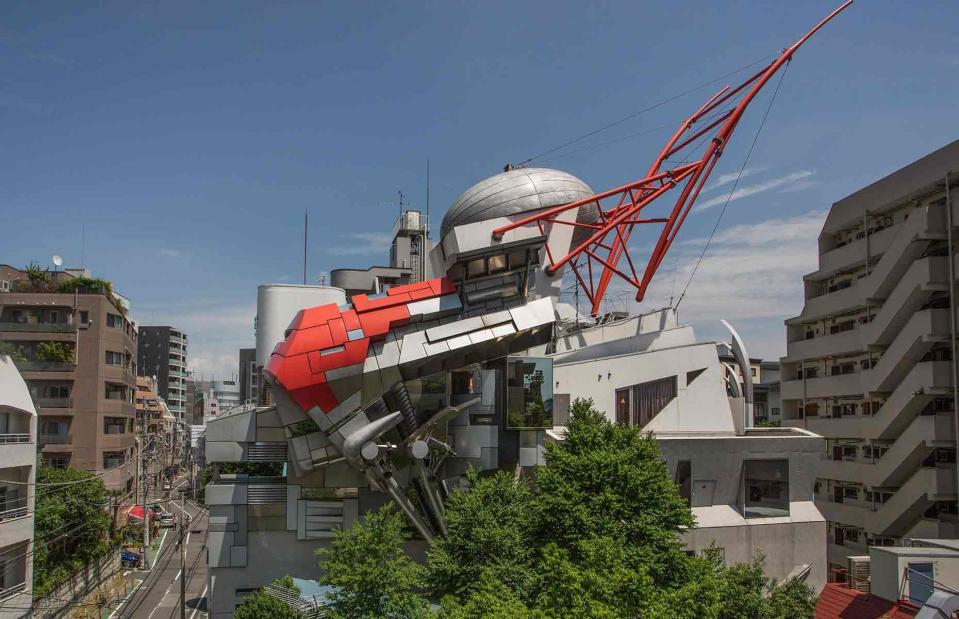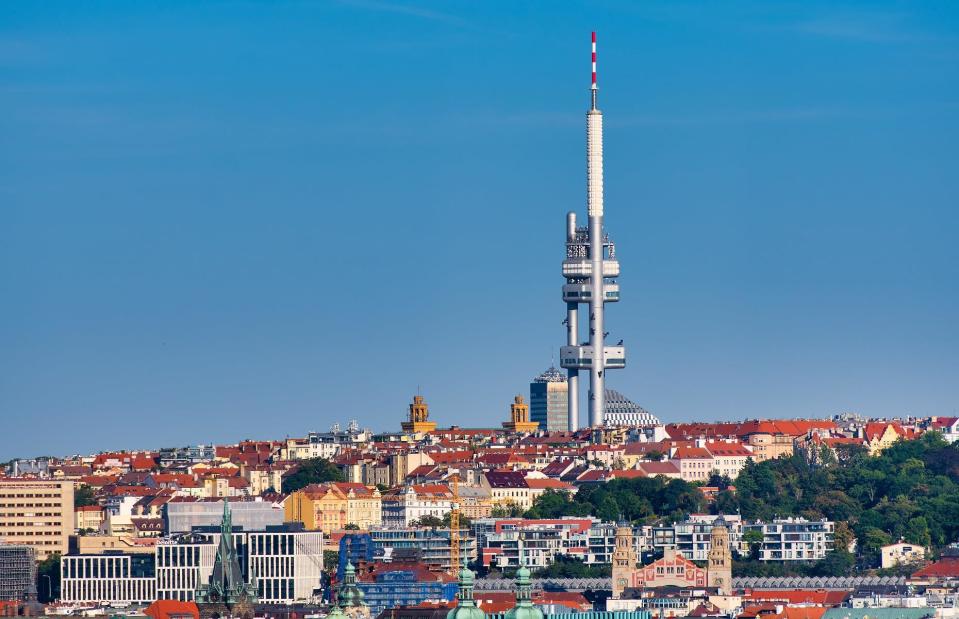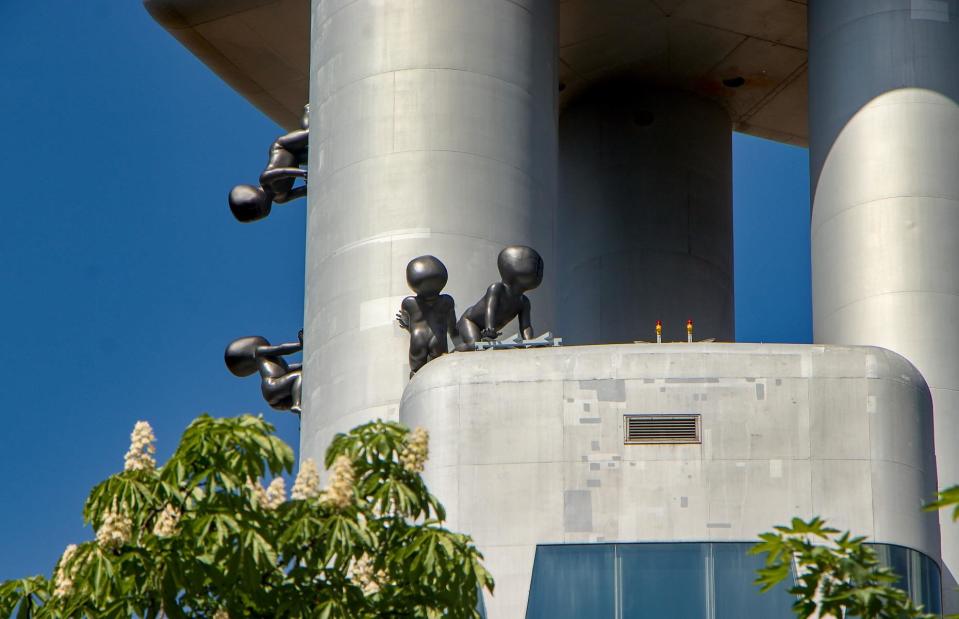15 controversial buildings you'll either love or hate
Love it or hate it: are these buildings icons or eyesores?

frantic00 / Shutterstock
It's often said that beauty is in the eye of the beholder; one person's eyesore is another's architectural masterpiece. While some critically acclaimed structures are rightly lauded for their ground-breaking designs, the court of public opinion isn't always so kind.
We've scoured the internet to uncover the most daring and divisive structures riling up locals and social media users across the globe. From brutalist icons to unusual and enigmatic landmarks, could these be the most controversial buildings in the world – or the most misunderstood? Read on and you decide...
Mäusebunker, Berlin, Germany

effjott.art / Shutterstock
One look at this stark, brutalist building and it isn't exactly hard to figure out why some Berlin residents dislike it. Known as the Mäusebunker (Mouse Bunker), the property has previously been named Berlin’s most controversial building, not just because of its looks.
It was built as an animal laboratory between 1971 and 1981. We must admit that it isn't difficult to imagine dark goings-on happening inside.
Mäusebunker, Berlin, Germany

Mo Photography Berlin / Shutterstock
The facility was designed by Gerd and Magdalena Hänska for the Freie Universität Berlin. It was later used for experimental medicine until it was closed in 2020. Many called for the demolition of the structure and permission was granted for its demise.
However, according to Hype&Hyper, "urbanists have fought to keep it in recent years" and finally Berlin city council granted Mäusebunker historic monument status – a move that also proved controversial with locals.
Fangyuan Mansion, Shenyang, China

Imaginechina Ltd / Alamy Stock Photo
Resembling an old Chinese coin, the Fangyuan Mansion was designed by Taiwanese architect C.Y. Lee, the man behind the tallest skyscraper in Taiwan, Taipei 101.
Completed in 2001, the bonkers Chinese building lies in the city of Shenyang and features 24 floors of offices. Adding to the controversy surrounding the building, according to HuffPost it cost almost £393 million ($500m).
Fangyuan Mansion, Shenyang, China

Zuma Press Inc / Alamy Stock Photo
In reimagining an ancient Chinese coin with the use of modern steel and concrete, Lee aimed to marry together old and new, east and west, underlining the hope for peace and harmony across the world.
However, rather sadly, the Fangyuan Mansion was voted one of the top 10 ugliest buildings in the world by CNN in 2012. Ironically, the very same year it was also crowned the most creative building at an architectural design convention in Venice. You win some, you lose some!
Velasca Tower, Milan, Italy

tichr / Shutterstock
Milan is a city known for its stunning architecture – the Duomo Di Milano and the Galleria Vittorio Emanuele II to name just a few. Yet did you know that the Italian fashion capital is also home to this rather obscure tower?
Constructed in 1958, Torre Velasca stands out as one of the few modern buildings in the city’s ancient centre.
Velasca Tower, Milan, Italy
![<p>CEphoto, Uwe Aranas / Wikimedia Commons [CC-BY-SA-3.0]</p>](https://s.yimg.com/ny/api/res/1.2/GIdO43vglthS1_jryOkY0A--/YXBwaWQ9aGlnaGxhbmRlcjt3PTk2MDtoPTYxOQ--/https://media.zenfs.com/en/loveproperty_uk_165/d05e03fee8a1d5677908dd49c5577413)
CEphoto, Uwe Aranas / Wikimedia Commons [CC-BY-SA-3.0]
A sort of weird skyscraper, Torre Velasca was designed by the architects at BBPR and spans 365,972 square feet. Its exterior soars up 348 feet over 28 floors and inside, it features offices, residential homes and retail spaces.
With its unusual shape – a modern interpretation of the medieval Sforzesco Castle – and stark, post-war aesthetic, the building has been described as one of the ugliest in the world.
The National Public Library, Pristina, Kosovo
![<p>qiv / Flickr [CC BY-SA 2.0]</p>](https://s.yimg.com/ny/api/res/1.2/Nm2dTg8osOlmkoouV4ITWg--/YXBwaWQ9aGlnaGxhbmRlcjt3PTk2MDtoPTYxOQ--/https://media.zenfs.com/en/loveproperty_uk_165/2b6fb848b56bc337465814fa82ad4369)
qiv / Flickr [CC BY-SA 2.0]
It would be quite hard to describe The National Public Library in Pristina, Kosovo, as pretty. In fact, the brutalist building is incredibly imposing and unsurprisingly, was extremely controversial when it was first unveiled. The library was designed by Croatian architect, Andrija Mutnjakovic, and its doors opened in 1982.
According to Architectuul, when Mutnjakovic was commissioned to design the structure, for the ex-Yugoslavian province, “the tension between Albanian and Serbian Kosovars was already palpable”. Looking for a unifying symbol, “he came up with the cube and dome, common features of the Ottoman and Byzantine architectural styles that define the appearance of the region”.
The National Public Library, Pristina, Kosovo

ColorMaker / Shutterstock
Despite Mutnjakovic's aim of creating a structure that symbolised freedom and unity, he inadvertently designed something that many believe looks like a prison.
Built from blocks and domes of concrete, and wrapped in a lattice-like sheet of metal, the building’s windows are all obstructed, giving a rather uninviting finish. In fact, many people consider the building to be one of the most unpleasant in Kosovo.
Liverpool Metropolitan Cathedral, Liverpool, UK
![<p>Ruaraidh Gillies / Flickr [CC BY-SA 2.0]</p>](https://s.yimg.com/ny/api/res/1.2/Bti7mzKwQexjQVJ6V2SSLw--/YXBwaWQ9aGlnaGxhbmRlcjt3PTk2MDtoPTYxOQ--/https://media.zenfs.com/en/loveproperty_uk_165/3dde3e221f4a3ac9c2756de7cc652bd9)
Ruaraidh Gillies / Flickr [CC BY-SA 2.0]
Designed to inspire awe and reverence among parishioners, religious buildings often feature stunning stonework and delicate stained-glass windows. However, Liverpool Metropolitan Cathedral offers a striking rebuttal to traditionalist architecture.
As one of the most unusual churches in the world, the UFO-like structure boasts a remarkable spire that resembles a crown of swords. So, how did such a unique structure come to be? Well, two far more conventional designs for the city's cathedral were proposed, but neither were built. So, in 1960, architects from around the world were invited to put forward their ideas.
Liverpool Metropolitan Cathedral, Liverpool, UK
![<p>David Iliff / Wikimedia Commons [CC BY-SA 3.0]</p>](https://s.yimg.com/ny/api/res/1.2/jYGHvczM6Tq2jGWQ2D4i7g--/YXBwaWQ9aGlnaGxhbmRlcjt3PTk2MDtoPTYxOQ--/https://media.zenfs.com/en/loveproperty_uk_165/29a60dfb4e6eaedd4f23f2f0dec319c0)
David Iliff / Wikimedia Commons [CC BY-SA 3.0]
The proposed churches needed to be quick and cheap to build and capable of accommodating around 2,000 people. Architects also had to feature a visible altar and also somehow incorporate a historic crypt.
This design, by Sir Frederick Gibberd, was chosen from 300 entries. The circular building, formed from 16 boomerang-shaped concrete trusses with the altar at its centre, fulfilled the competition's tricky brief. While its unconventional architecture has caused controversy, it's arguably one of the most innovative religious buildings in the world and we can't help but love its atmospheric interior.
Trump Tower Las Vegas, Nevada, USA
![<p>Steve Jurvetson / Flickr [CC BY 2.0]</p>](https://s.yimg.com/ny/api/res/1.2/UjsdRtILDE.kkfPB49tCkg--/YXBwaWQ9aGlnaGxhbmRlcjt3PTk2MDtoPTYxOQ--/https://media.zenfs.com/en/loveproperty_uk_165/733fdf8dbf5cc20649bf7428abe5812e)
Steve Jurvetson / Flickr [CC BY 2.0]
Former president Donald Trump isn't exactly known for his minimalist taste. The eclectic style displayed in his own residences is ostentatiously heavy on the bling: think sparkling crystal chandeliers, gilded details and plush cream carpets. And no building quite exemplifies his design preferences better than Trump Tower in Las Vegas.
With a glistening, 24-carat gold façade, its eye-catching material choices have rubbed some critics the wrong way over the years. Rightly or wrongly, builders' merchants Buildworld even named it the sixth-ugliest building in America and the 10th-ugliest in the world in their 2023 ranking, which was calculated by analysing the language people used when talking about certain buildings on Twitter.
Trump Tower Las Vegas, Nevada, USA
![<p>prayitnophotography (Thank You (24 Millions ) views) / Flickr [CC BY 2.0]</p>](https://s.yimg.com/ny/api/res/1.2/BTQ44aXok0bAp5Z2j3u8NQ--/YXBwaWQ9aGlnaGxhbmRlcjt3PTk2MDtoPTYxOQ--/https://media.zenfs.com/en/loveproperty_uk_165/2f970002560969b0da256d380d858732)
prayitnophotography (Thank You (24 Millions ) views) / Flickr [CC BY 2.0]
The 64-storey hotel and residential condo was developed by Trump and fellow American businessman Phil Ruffin between 2005 and 2008, at a reported cost of £236 million ($300m).
Inside, the landmark tower features high-end hotel suites with marble bathrooms, an upscale restaurant that serves only American cuisine, a spa and an outdoor heated pool. But who cares about what's going on inside when the exterior is dripping in gold?
MI6 Building, London, UK

Svet foto / Shutterstock
If you've ever watched a James Bond movie, then you'll likely recognise this building. The HQ of MI6, the UK's Secret Intelligence Service, the structure is defined by its Tetris-like concrete blocks, green glass and interlocking roof terraces – and there are said to be 60 in total.
It lies on the River Thames in Vauxhall, London, and thanks to its distinctive form, it has gained plenty of affectionate nicknames, including Legoland and The Ziggurat. Fairly intimidating in stature, it isn't hard to believe that this is where spies prepare for their secret missions.
MI6 Building, London, UK

Victor Moussa / Shutterstock
The fortress was designed by Sir Terry Farrell and completed in the early 1990s. Farrell is said to have been inspired by Aztec temples and 1930s industrial modernist architecture like Battersea Power Station.
Due to the sensitive nature of MI6’s work, the building was made impenetrable, with numerous underground rooms connected by secret tunnels. Despite its revered status and architectural merit, Buildworld named the landmark the fifth-ugliest in Britain and 14th-ugliest in the world. Love it or hate it, it's undeniably an iconic London landmark.
The Museum of Pop Culture, Washington, USA
![<p>Burley Packwood / Wikimedia Commons [CC BY-SA 4.0]</p>](https://s.yimg.com/ny/api/res/1.2/YNNTgd4.3or7iMMVYNtFrw--/YXBwaWQ9aGlnaGxhbmRlcjt3PTk2MDtoPTYxOQ--/https://media.zenfs.com/en/loveproperty_uk_165/719ea790e464481831dbc905e1f71875)
Burley Packwood / Wikimedia Commons [CC BY-SA 4.0]
If you've never been to Seattle, Washington you might not know what this enigmatic masterpiece is. Well, the Museum of Pop Culture, or MoPOP for short, is home to an extensive collection of memorabilia and artefacts from the worlds of music, film and video games.
The building was masterminded in 2000 by billionaire Paul Allen, the co-founder of Microsoft. Originally known as the Experience Music Project, the architecture of the building was designed to convey "the energy and fluidity of music".
The Museum of Pop Culture, Washington, USA

Sergii Figurnyi / Shutterstock
Architectural heavyweight Frank O. Gehry designed the museum and took inspiration from electric guitars. He sliced some of the instruments into pieces and used them as building blocks for an early model. Spanning 140,000 square feet, the structure features a free-flowing form covered in 3,000 panels, made up of 21,000 individually cut, shaped and painted aluminium and stainless steel shingles.
These pieces reflect the light, offering a different perspective from every angle. Though some have taken a disliking to the bold building, there's no denying that its design is ground-breaking, plus there's something rather alluring about that ever-changing façade.
J. Edgar Hoover Building, Washington, DC, USA
![<p>Brunswyk / Wikimedia Commons [CC BY-SA 3.0]</p>](https://s.yimg.com/ny/api/res/1.2/b5hSqM4xPPteboz81LMjvw--/YXBwaWQ9aGlnaGxhbmRlcjt3PTk2MDtoPTYxOQ--/https://media.zenfs.com/en/loveproperty_uk_165/86d4ef84aa25b4b75b249b9c74ee7427)
Brunswyk / Wikimedia Commons [CC BY-SA 3.0]
Secret service agencies around the world clearly all have a propensity for divisive architecture because the striking headquarters of the FBI has been named by Buildworld as the ugliest building in America and the second-ugliest in the world.
In fact, they found that over one-third of tweets about the structure were negative in sentiment, however, they did acknowledge that "there’s a certain Minecraft-y charm about the blocky brutalist monolith".
J. Edgar Hoover Building, Washington, DC, USA
![<p>Stanislav Kozlovskiy / Wikimedia Commons [CC BY-SA 3.0]</p>](https://s.yimg.com/ny/api/res/1.2/lWBhCWhBaaWbbpB4mnxk3Q--/YXBwaWQ9aGlnaGxhbmRlcjt3PTk2MDtoPTYxOQ--/https://media.zenfs.com/en/loveproperty_uk_165/a4568b85d90ace5f50a967681d550b4c)
Stanislav Kozlovskiy / Wikimedia Commons [CC BY-SA 3.0]
Known as the J. Edgar Hoover Building, the low-rise office block is located in the heart of Washington, DC and was completed in 1974. Designed by Charles F. Murphy and Associates, the building cost a staggering £99 million ($126m) to construct. While the structure certainly has its critics, it's also an important landmark in the history of American architecture.
It's no secret that brutalism has somewhat fallen out of contemporary favour, however, architecture professor Mark Pasnik rushed to the defence of brutalist municipal buildings like this: "They were actually envisioned as being monumental symbols of how important the civic realm was", he explained to WBUR.
Aoyama Technical College, Tokyo, Japan

Prisma by Dukas Presseagentur GmbH / Alamy Stock Photo
Aoyama Technical College in Tokyo, Japan, is one of the most innovative urban structures across the globe, notable for its use of unconventional materials. Its eye-catching, irregular form has seen it likened to a Transformers character, while Architecture Tokyo called it "a cross between an insect and a motorcycle".
Positioned on an unassuming residential street, it's no surprise that the daring educational institution specialises in teaching architecture. A melting pot of styles, the cutting-edge building was finished in 1990 and was the first major project by award-winning architect Makoto Sei Watanabe.
Aoyama Technical College, Tokyo, Japan

Manuel Ascanio / Shutterstock
When you take a closer look, all the various elements of the bold, futuristic building come into focus. The main body is made up of "posts, water tanks, lightning rods and joints of various kinds", according to the architect himself.
The exterior is clad in aluminium panels in four colours, giving the façade a unique, blocky finish. Architecture Tokyo suggests the mysterious building perfectly suits the "disorderly, chaotic area in which it stands". We can't help but admire its masterful design.
Denver International Airport, Colorado, USA
![<p>Unknown author / Wikimedia Commons [Public Domain]</p>](https://s.yimg.com/ny/api/res/1.2/jeTucBuCDGqqP08WfpIYww--/YXBwaWQ9aGlnaGxhbmRlcjt3PTk2MDtoPTYxOQ--/https://media.zenfs.com/en/loveproperty_uk_165/b128fe8f5b9111f7a60e0b76abd9b03b)
Unknown author / Wikimedia Commons [Public Domain]
No, you're not looking at the tents of Glastonbury – this fascinating building is actually Denver International Airport (DIA), which was named Best Large Airport in the 2021 USA Today Readers’ Choice Awards. Not all of its accolades are quite as glowing though.
Buildworld declared the building the ninth-ugliest in the world and the fifth-ugliest in America, yet others laud the structure as a pioneering transport hub. It was designed in the early 1990s by Curtis W. Fentress, who came aboard when the project was already behind schedule and over budget. According to Architonic, he was given just three weeks to come up with a new concept.
Denver International Airport, Colorado, USA
![<p>Peterquinn925 / Wikimedia Commons [CC BY-SA 4.0]</p>](https://s.yimg.com/ny/api/res/1.2/O8yVw_SaAh8Y4bWWmCE9Rw--/YXBwaWQ9aGlnaGxhbmRlcjt3PTk2MDtoPTYxOQ--/https://media.zenfs.com/en/loveproperty_uk_165/01e9279fb89b24fa4057b4bb68e28d1f)
Peterquinn925 / Wikimedia Commons [CC BY-SA 4.0]
To speed things up and reduce costs, Fentress opted to cover the structure with what was then the world’s largest fabric roof. An inspired move, the lightweight canopy replaced thousands of tonnes of steel, reduced the build schedule by nine months and saved £90 million ($115m). But that isn't the only interesting thing about DIA.
Strangely, there are numerous sensational myths about the building. According to some conspiracy theorists, the Freemasons control the airport, while others say it’s home to a secret underground city that will protect the world's elite in the event of the apocalypse. Sounds legit...
Žižkov Television Tower, Prague, Czech Republic

michelangeloop / Shutterstock
Prague is home to some truly incredible architecture, from the Powder Tower to St Nicholas Church. Yet some of the standout landmarks in the Czech city have sparked controversy too, including Žižkov Television Tower.
The TV transmitter is the tallest building in the Czech Republic, soaring some 709 feet, and was designed by architect Václav Aulický. Construction began in the 1980s and the tower was finally opened in 1992. Sitting on three pillars, its daring, futuristic form has the appearance of a rocket about to be launched into space.
Žižkov Television Tower, Prague, Czech Republic

islavicek / Shutterstock
Yet the tower has another unique detail. Its exterior is covered in small statues of crawling babies. The art installation was created by David Černý and was added to the tower at the turn of the millennium.
The unusual figurines are said to be a symbol of the Communist Era when the country was stifled under totalitarian rule and unable to grow. While it's certainly been the subject of debate in the city, it's become a prominent part of Prague's skyline and a must-see for many tourists, offering breathtaking views from the observation deck.
US Bank Stadium, Minnesota, USA

Mark Herreid / Shutterstock
The US Bank Stadium in Minneapolis is a cutting-edge sports centre. Its sleek exterior and distinctive angular lines have a futuristic appeal, but it has surprisingly been the subject of ire from some locals. So what makes the structure so controversial?
Well, perhaps the price tag put some locals' noses out of joint. The striking multi-purpose stadium, home of the Minnesota Vikings, is said to have cost just under £863 million ($1.1bn) to build.
US Bank Stadium, Minnesota, USA
![<p>Sharon Mollerus / Flickr [CC BY 2.0]</p>](https://s.yimg.com/ny/api/res/1.2/bF5FS7_iszRgufHvzE878g--/YXBwaWQ9aGlnaGxhbmRlcjt3PTk2MDtoPTYxOQ--/https://media.zenfs.com/en/loveproperty_uk_165/3e900400f85297ad06a4e7e0e8a6b4c3)
Sharon Mollerus / Flickr [CC BY 2.0]
The Vikings reportedly wanted an outdoor stadium, but they were only given funding from state and local governments for an indoor stadium. So Architecture firm HKS, Inc. decided to cover the building in a streamlined glass skin. The stadium features glazed entrances with giant pivoting doors, as well as walls of windows, allowing fans to see all the way to downtown Minneapolis.
The structure also boasts a translucent roof, one of the largest in North America, with a diagonal design that allows it to endure heavy snow loads. However, due to the highly reflective nature of the exterior, there have sadly been many bird fatalities.
Boston City Hall, Massachusetts, USA
![<p>Gunnar Klack / Flickr [CC BY-SA 2.0]</p>](https://s.yimg.com/ny/api/res/1.2/157waFrL3Z.l9yG03UUA9g--/YXBwaWQ9aGlnaGxhbmRlcjt3PTk2MDtoPTYxOQ--/https://media.zenfs.com/en/loveproperty_uk_165/1f747a23a3897c3277b9d480ef5421a5)
Gunnar Klack / Flickr [CC BY-SA 2.0]
Boston City Hall in Massachusetts is a historically important example of brutalist architecture designed by Kallmann McKinnell & Knowles back in 1963. The seat of the municipal government of Boston, the structure was the result of yet another competition.
Out of the 256 entries received by the design jury, this was the lucky design selected. The monumental structure is built from coarse rock columns and precast Portland cement and masonry blocks.
Boston City Hall, Massachusetts, USA
![<p>NewtonCourt / Wikimedia Commons [CC BY-SA 4.0]</p>](https://s.yimg.com/ny/api/res/1.2/FRniIAuUHoX8CZ7rzg0ujA--/YXBwaWQ9aGlnaGxhbmRlcjt3PTk2MDtoPTYxOQ--/https://media.zenfs.com/en/loveproperty_uk_165/2519b7ce4c33f44689794cff3ac10957)
NewtonCourt / Wikimedia Commons [CC BY-SA 4.0]
Despite its architectural significance, the structure has divided opinion. It was declared the second-ugliest building in America and fourth-ugliest in the world by Buildworld. However, the municipal structure has its champions, too.
Boston historian Douglass Shand-Tucci described it as "arguably the great building of twentieth-century Boston". Over the years, there have been several plans to demolish the structure, but thankfully none have come to fruition.
The Spittelau, Vienna, Austria

frantic00 / Shutterstock
As well as being truly bonkers to look at, The Spittelau in Vienna, Austria, has a rather unique job; it's the waste incineration plant for the city. The facility was constructed in the late 1960s, but was partially rebuilt in 1987 after a fire broke out.
Very controversial, due to its size, position next to the river and proximately to the city centre, many called for it to be moved to a new location following the blaze, but reportedly this would have been far too expensive for the local authorities.
The Spittelau, Vienna, Austria

Guniva / Shutterstock
Instead, local officials managed to persuade Austrian visual artist and architect, Friedensreich Hundertwasser, to redesign the façade of the building and its rather indiscrete chimney. Hundertwasser took on the task and designed something that no local or tourist will ever forget.
A quirky mix of colours, patterns and ideas, The Spittelau is now considered one of Vienna’s most striking landmarks, with its checkerboard exterior, randomly scattered frescos and huge golden ball on its chimney. Like it or loathe it, there's no denying this building is one-of-a-kind!


